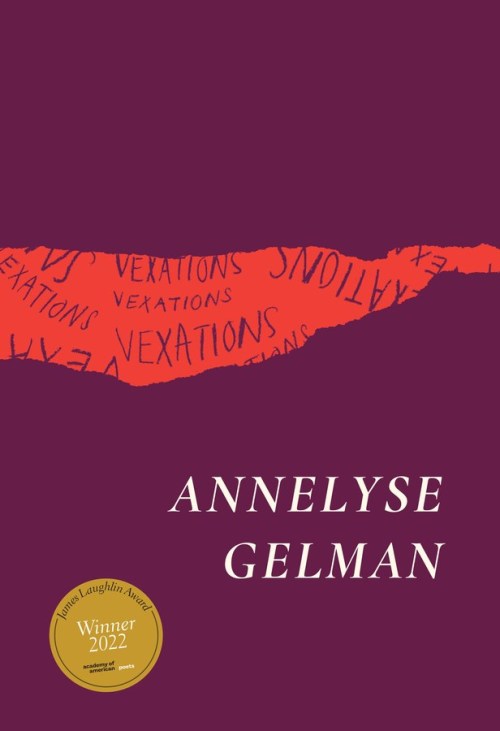[ad_1]
Annelyse Gelman’s curiosity and passion for language, multi-disciplinary collaboration, and experimentation imbue all her projects. Two of them—her new full-length poem, Vexations, and website Midst—also prove her fascination with craft and process. In our free-ranging conversation—encompassing poems as objects, durational art, text scores, endless beginnings and endings, and generative collaborations—Gelman’s enthusiasms are front and center.
This interview has been edited for clarity and length.

Mandana Chaffa
There’s something thrillingly ambitious—and leisurely—about a full-length poem in our instamatic, flash world, Annelyse. Would you talk about how you imagined Vexations before you started working on it? Were you always thinking of it in this form?
Annelyse Gelman
The contrast between a poem as an “object” (a static, stable entity, with one form and fixed boundaries) and an “event” (a dynamic, ongoing, mutable performance) has always intrigued me. Is a poem more based in space or in time? Is it more like a sculpture or a film? More urgently, is the poem itself really what’s important, or am I more concerned with how it lives in the reader’s mind during and after an encounter? Words on a page don’t mean or do anything on their own, right? Poems are experiences that live in and depend upon attention. To put it in starker terms: is a poem dead or alive?
I think these questions have their origin in childhood existential crises (and my adolescent experiences with spoken word poetry), and they solidified as I discovered I wasn’t the only one thinking about them—there’s that famous Valery quote, for example: “A poem is never finished, only abandoned,” which suggests to me that a poem wants to continue unfolding, continue responding to its context, like an organism.
One summer, in college, I received a grant to go study the brain of H.M., a famous amnesiac who lost his memories of both the past and the future. He was severely disabled as a result—trapped in an eternal present—with the constant feeling of awakening into the consciousness of the present moment. Clive Wearing is another similar patient, and there’s fascinating documentary footage of him greeting his wife (of whom he fortunately retained recognition) exuberantly at the hospital, as though he hasn’t seen her for years—big hugs, smiles, joy. She goes out into the hallway for two minutes and comes back into his room—big hugs, smiles, joy, he hasn’t seen her for years! I was curious about how to enact a poetics of losing oneself in time, of endless beginnings which are also endless endings.
I thought I would write a series of pamphlets that were bound with magnets and could be rearranged by the reader. There were three in the end: Recollection, Perception, and Imagination, representing the past, present, and future of a single subjectivity. Of course, I was 19 or 20 years old and what I made didn’t quite meet my ambition—but I can see now, looking back, how this lifelong line of questioning is also the seed of Vexations, particularly in its almost tediously uniform structure. And with Vexations, I was able to bring this questioning about object and event, memory and attention, time and space, into conversation with other urgent matters—late capitalism, the ecological worldview, cognitive science, all the fields of study I’ve engaged with since then. I wrote the first draft in the summer of 2019, when I was 27, on one of my summers off from grad school.
Mandana Chaffa
Gunnhild Øyehaugh’s Present Tense Machine, translated by Kari Dickson, also examines Erik Satie’s “Vexations,” as a piece of music that links two narratives, and two different planes of existence. I understand that “Vexations” embraced “enharmonic” equivalency, whereby a note, or phrase is similar to another. It’s assumed that the piece should be played 840 times, and the first marathon was led by John Cage. How did such enharmonies and repetitions play into the development of the poem?
Annelyse Gelman
I feel like I ought to mention a caveat here—I’m very much an “outsider” when it comes to music and am self-taught (either learning things totally on my own, or picking up little bits and pieces from friends who know much more than I do). So it’s possible my perspective on this is incorrect or deranged somehow. But as far as I understand it, “enharmonics” simply means that we can call the black piano key between G and A a “G sharp” or an “A flat.” The actual content of the note remains the same (440hz is 440hz), but the way we hear it changes depending on the musical context—the key of the song, what the listener anticipates, what comes before or after that note.
Thinking through ideas like this is obviously very rich for poetry, which is so caught up in repetition and variation, pattern and surprise, establishing and breaking rules, tuning into the reader’s expectations. One expectation is of a kind of respect for the reader’s time and attention (the only real reason, IMO, to value concision, density, economy, and all that offensively prescriptive styling). My hope with Vexations was to provide enough repetition of words and phrases to get this moody, glitchy, trapped ambience across—like Satie’s piece, it’s playing with the idea of the promise that the art will “take” you somewhere, that you’ll “arrive”; it’s a little tedious, purposefully. At the same time, repetition is happening on other scales. For example, the way the lines cut aggressively from image to image, scene to scene—that’s also a kind of repetition (there is almost no enjambment in the whole book, and almost all the lines are implicitly endstopped). So even if the “content” is moving at a frenzied (dare I say entertaining?) pace, that sense of stagnation is always running underneath.
I thought a lot about durational art as I was making Vexations—James Turrell, drone music, Walter de Maria’s The Lightning Field, the way our perception treats short events and long events differentially. There is also the influence of my background in psychology (what I studied at Reed College)—basic cognitive concepts like chunking, primacy and recency effects, priming and suggestion, and so on—and how these play out in the context of a long poem that is catchy and memorable but also overflows the audience’s attentional capacity, particularly in the context of listening rather than reading.
Mandana Chaffa
Would you talk more about the idea of a “text score”?
Annelyse Gelman
I’m really intrigued by the idea of a “text score”—something I learned about from Luke Martin and Aaron Foster Breilyn, who organize the experimental music gathering called The Co-Incidence Festival. For me, it is an invitation to situate poetry in a performative, time-contingent mode. The “score” suggests a set of instructions, or commands, as well as a container for potential events or actions—and this container can be as restrictive as bondage, or extremely porous and flexible…there’s a lot you can do with it. For Vexations, I was thinking a lot about how poetry on the page “scores” mental movements—a poem, as you read it, is conducting your mind, directing it to move in this way and that, to imagine or consider something, to think thoughts that aren’t “yours” and perhaps be changed by that. And I was thinking about performing the poem alongside Satie, literally and figuratively. I was also thinking a lot about “spoken word” and the possibilities there beyond the poetry slam.
This is not to disparage poetry slam, as a culture or as an artform—immersing myself in that scene [when I was younger] was hugely formative, hugely positive, for me, and for so many other poets who came up in that scene. My point is that when I discovered text scores, I felt, wow, this is a way I can engage with spoken word and all the great things about it without the trappings of how that usually happens in the world at slams and open mics, where the default assumption is that you’re doing something short and instantly gratifying. Now I could think about other aspects of performance. It’s really interesting to try to create something that truly sings whether on the page or out loud.
Spoken word is really great at this audience-oriented, very generous mode, because unlike reading a book, a listener can’t control the pacing of a spoken word poem, or pause and linger on a particular phrase before moving on. Spoken word can be really accessible, understandable, immediate, intimate—the audience is going to hear it once, and they have to be able to grasp it, so clarity is very important. But also the poem has to be able to stand up to a lot of repetition, to have that complexity and density and more fully-realized artistic vision behind it. And that’s what “page poetry” is good at—because it can’t get away with being superficially pleasing or interesting or moving the way spoken word can.
My hope with Vexations is that there’s both clarity and complexity—and, especially when it’s read aloud, that it forces the listener to really confront this constant torquing of attention, the inability to really hold the whole thing in mind at once, how focusing on one line blurs the one that comes after, to play around with different “styles” of listening and thereby participate in the performance, turning listening into a kind of instrument.
Mandana Chaffa
The beginning puts us squarely in heart of the poem and where it is taking us, both not of and deeply indicative of our own times (let alone my nerdy linguistic joy in the word “saccade”):
“Even the grass was coming up positive
Soles beading little match tips of blood
A reticular glitch made me saccade like crazy
Clouds like anemones, electric fortresses
A dandelion fluff might fly in your mouth
As you ate a hamburger, the last hamburger”
Not to get too process-oriented, but is this where you started? Was this always the beginning of the collection, or did you have to start elsewhere to get here? In a broader sense, how did you construct the poem; in a linear fashion, or like a puzzle, establishing the corners and then filling in the pieces?
Annelyse Gelman
Vexations did begin with this form—and this first stanza! If you think of a poem as a kind of game between the text and the reader, beginnings are especially important for establishing the field of play, and there’s a lot happening just in these first six lines that unfolds throughout the entire book. There’s the breadth of tone (ominous, speculative, naïve, funny) and diction (scientific, pastoral, childlike, quotidian), the sense of movement within and across lines, rapid changes in scale, the scene-setting which gets continually reenacted over the course of the text, etc. In addition to Vexations’ particular flavor of estrangement, I also wanted to immediately set up the reader’s relationship to time: This is a voice from the future whose past is (or could be) our present. And as this first page unfolds, it’s clear that “the world” is as much in focus as a particular set of characters, who are subject to that world; they are not heroes; foreground and background, subject and setting, are blurring together.
The overall development of the structure was much more nonlinear. I initially treated the lines as these fluid, modular units, placing them into different contexts and combinations—like chords. The larger structures of stanzas, and then pages, followed that. The act of arranging and rearranging these variously sized units was just as much (perhaps more) a part of the process as actually “writing” the words in the book. My initial intent was to create a poem which could potentially be rearranged indefinitely (even by the reader)—you might walk into a room where the poem is installed as audio, for example, hearing one of thousands or millions of configurations of the poem, with your very presence altering which lines are selected or what they sound like. I struggle with narrative and plot and character, and didn’t plan for Vexations to include any story at all. But then the daughter appeared, almost against my will, and the character of the mother was (paradoxically) born out of the child—and the two of them became an undeniably linear thread, a crystallizing or stabilizing force buttressing the precarious and indeterminate world of the poem.
Mandana Chaffa
I know that you’re deeply engaged with form and content; from literal chapbook creation to the process through which a poem is created. Can we talk about Midst? As writers, many of us are fixated on others’ processes; how a poet initiates, alters and finalizes a poem, and with Midst, you’re focused on capturing, sharing, and exploring said progressions. How has the experience been for you? What are the challenges of depicting that on a digital platform?
Annelyse Gelman
It’s been extremely rewarding to work on a project that not only contributes to my personal art practice, but also serves as a creative tool for other artists to use. That’s still tremendously exciting to me. That Midst also serves as a pedagogical and scholarly resource, as well as a future laboratory for experimenting with decentralized publishing, is even better!
The main challenge is technical—it’s very time-consuming and complex to build and maintain software. The heart of Midst is a word processor specially built to capture and play back the writing process, keystroke by keystroke, capturing typing, deleting, reformatting, etc., as well as timestamps. Thanks to my friend Jason Gillis-Grier—a software developer and accomplished musician and producer—we’ve been able to get the initial software working, but we’re still working on a more robust version of it, which will be open source and free for anyone to download and use, whether or not they share their work on the midst.press publishing platform.
Mandana Chaffa
Would you talk more about your collaboration philosophies? It’s central to the work you do and enjoy.
Annelyse Gelman
My friend Auden Lincoln-Vogel recently pointed out that my collaborations tend to be structured such that other people contribute within a framework I’ve set ahead of time. He’s absolutely right. On one hand, one of my greatest joys as an artist is in bringing different skillsets (and life experiences) together to create something new and surprising.
On the other hand, I’m kind of a control freak when it comes to art. I’ve found I can balance these approaches—as opposed as they are—by creating situations where what I’ve done is incomplete and curtailed, and already has space for others to step in and really have a transformative impact. I set up the scaffolding; we build together.
Midst definitely reflects this dynamic—I have a very clear vision for the project, including where I’d like to take the concept over the coming years if logistics allow (in brief: a radical inversion of the submissions/gatekeeping editorial process). But within that concept, there’s total freedom for the poets who contribute. Right now, since we’re still building the tech and it’s a little cumbersome to install and use, I’m doing everything through one-on-one commissions. And I tell each poet: here’s the software, have fun, take as long as you need, there is no deadline—when you have something you like and are ready to share, send it to me. I don’t give any editorial guidance whatsoever; and even as the commissioning editor, I don’t only look for poets whose work suits my taste. I love that, even now, Midst is not about Annelyse Gelman and what she thinks is “worthy.” I have faith in the poets who are willing to participate—which is so brave, and so vulnerable!—and I trust them to know when they have something worth publishing.
Many of my other projects employ this “framework” style of collaboration. To give another example: I’m working slowly on an album of my songs totally based around other musicians’ improvisations. For that, I record scratch guitar/keys and vocals, then run that through headphones and record a bunch of takes with (for instance) a cellist playing over it. Then I’ll throw out everything but the cello and compose and arrange the song from there, so that the feel of the finished recording is as much about these improvisations (often by strangers) as it is about “my” song.


POETRY
Vexations
by Annelyse Gelman
University of Chicago Press
Published March 31, 2023
[ad_2]
Source link

